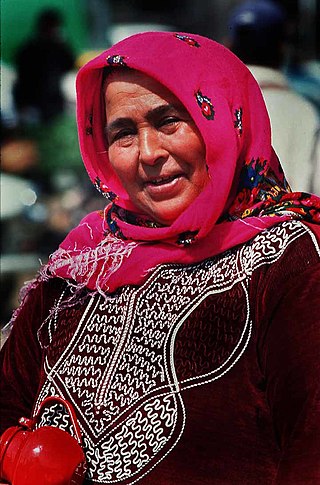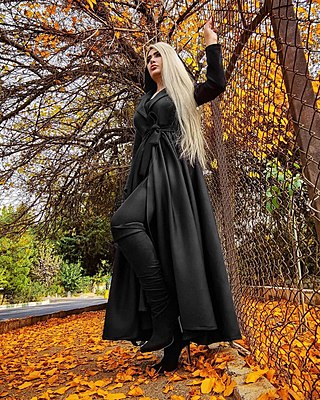Mahla Zamani is an Iranian fashion designer, journalist and expert on Iranian traditional clothing.
Mahla Zamani is an Iranian fashion designer, journalist and expert on Iranian traditional clothing.
She established the first fashion exhibition after the Iranian revolution (1979) and put significant effort in popularizing Iranian stylish clothing. In her view, Iranians need to revive their past and dress in elegant colorful and traditional styles (instead of black and Arabian dresses). Her efforts in advertising Persian, Qashqai, Kurdish, Turkmen and Baloch dress styles attracted international attention.
She has been attacked by fundamentalist circles and newspapers repeatedly. [1]
In 2001 Zamani received permission to launch Lotus: A Persian Quarterly, Iran's first fashion magazine [2] and the first Iranian magazine to show the faces of women since the establishment of the Islamic Republic. [3]
Zamani was asked to design a dress for Queen Saleha of Brunei as a gift from Iran. [4]

Cross-dressing is the act of wearing clothes traditionally or stereotypically associated with a different gender. From as early as pre-modern history, cross-dressing has been practiced in order to disguise, comfort, entertain, and express oneself.

In modern usage, hijab generally refers to various head coverings conventionally worn by many Muslim women. It is similar to the tichel or snood worn by Orthodox Jewish women, certain headcoverings worn by some Christian women, such as the mantilla, apostolnik and wimple, as well as the dupatta worn by many Hindu and Sikh women. While a hijab can come in many forms, it often specifically refers to a headscarf, wrapped around the head, covering the hair, neck and ears, but leaving the face visible. The use of the hijab has been on the rise worldwide since the 1970s and is viewed by many Muslims as expressing modesty and faith. There is a consensus among Islamic religious scholars that covering the head is either required or preferred, though some Muslim scholars and activists argue that it is not mandated.

Godey's Lady's Book, alternatively known as Godey's Magazine and Lady's Book, was an American women's magazine that was published in Philadelphia from 1830 to 1878. It was the most widely circulated magazine in the period before the Civil War. Its circulation rose from 70,000 in the 1840s to 150,000 in 1860. In the 1860s Godey's considered itself the "queen of monthlies". After several changes, it ceased publication in 1896.

A wedding dress or bridal gown is the dress worn by the bride during a wedding ceremony. The color, style and ceremonial importance of the gown can depend on the religion and culture of the wedding participants. In Western cultures and Anglo-Saxon cultural spheres, the wedding dress is most commonly white, a fashion made popular by Queen Victoria when she married in 1840. In Eastern cultures, brides often choose red to symbolize auspiciousness.

A crinoline is a stiff or structured petticoat designed to hold out a skirt, popular at various times since the mid-19th century. Originally, crinoline described a stiff fabric made of horsehair ("crin") and cotton or linen which was used to make underskirts and as a dress lining. The term crin or crinoline continues to be applied to a nylon stiffening tape used for interfacing and lining hemlines in the 21st century.

A kaftan or caftan is a variant of the robe or tunic. Originating in Asia, it has been worn by a number of cultures around the world for thousands of years. In Russian usage, kaftan instead refers to a style of men's long suit with tight sleeves.
Islamic clothing is clothing that is interpreted as being in accordance with the teachings of Islam. Muslims wear a wide variety of clothing, which is influenced not only by religious considerations, but also by practical, cultural, social, and political factors. In modern times, some Muslims have adopted clothing based on Western traditions, while others wear modern forms of traditional Muslim dress, which over the centuries has typically included long, flowing garments. Besides its practical advantages in the climate of the Middle East, loose-fitting clothing is also generally regarded as conforming to Islamic teachings, which stipulate that body areas which are sexual in nature must be hidden from public view. Traditional dress for Muslim men has typically covered at least the head and the area between the waist and the knees, while women's islamic dress is to conceal the hair and the body from the ankles to the neck. Some Muslim women also cover their face. However, other Muslims believe that the Quran does not mandate that women need to wear a hijab or a burqa.

The hanbok is a traditional clothing of the Korean people. The term hanbok is primarily used by South Koreans; North Koreans refer to the clothes as chosŏn-ot. The clothes are also worn in the Korean diaspora, especially by Koreans in China.
Throughout history, women in Iran have played numerous roles, and contributed in many ways, to Iranian society. Historically, tradition maintained that women be confined to their homes to manage the household and raise children. During the Pahlavi era, there was a drastic social change towards women's desegregation such as ban of the veil, right to vote, right to education, equal salaries for men and women, and the right to hold public office. Women were active participants in the Islamic Revolution. Iran's constitution, adopted after the Islamic Revolution in 1979, proclaims equality for men and women under Article 20, while mandating legal code adhering to Sharia law. Article 21 of the constitution as well as a few parliament-passed laws give women rights such as being allowed to drive, hold public office, and attend university but not wearing a veil in public can be punished by law; and when in public, all hair and skin except the face and hands must be covered. However, this is often not enforced; notably in recent years, Iranian women have started a number of groups to rebel against the government's oppressive policies and reclaim their independence and rights.
Shirin Guild is an Iranian-born British fashion designer. Her fashion label was established in London, in 1991. Her clothing design is minimalist and she has reworked Iranian clothing traditions through a "reductionist aesthetic". Her design work has been described as "trans-cultural".

A dress is a garment traditionally worn by women or girls consisting of a skirt with an attached bodice. It consists of a top piece that covers the torso and hangs down over the legs. A dress can be any one-piece garment containing a skirt of any length, and can be formal or casual.

Anti-fashion is an umbrella term for various styles of dress which are explicitly contrary to the fashion of the day. Anti-fashion styles may represent an attitude of indifference or may arise from political or practical goals which make fashion a secondary priority. The term is sometimes even used for styles championed by high-profile designers, when they encourage or create trends that do not follow the mainstream fashion of the time.

Various styles of head coverings, most notably the khimar, hijab, chador, niqab, paranja, yashmak, tudong, shayla, safseri, carşaf, haik, dupatta, boshiya and burqa, are worn by Muslim women around the world, where the practice varies from mandatory to optional or restricted in different majority Muslim and non-Muslim countries.

Shalwar kameez is a traditional combination dress worn by women, and in some regions by men, in South Asia, and Central Asia.

Norma Kamali is an American fashion designer. She is best known for the "sleeping bag" coat, garments made from silk parachutes, and versatile multi-use pieces.

Fashion in the twenty years between 1775 and 1795 in Western culture became simpler and less elaborate. These changes were a result of emerging modern ideals of selfhood, the declining fashionability of highly elaborate Rococo styles, and the widespread embrace of the rationalistic or "classical" ideals of Enlightenment philosophes.

On 8 January 1936, Reza Shah of Iran (Persia) issued a decree known as Kashf-e hijab banning all Islamic veils, an edict that was swiftly and forcefully implemented. The government also banned many types of male traditional clothing. The ban was only enforced for a period of five (5) years (1936-1941), however, since then, the hijab in Iran has been a mandatory hallmark of the Islamic Republic for 44 years. One of the enduring legacies of Reza Shah has been turning dress into an integral problem of Iranian politics.

Fashion and clothing in Iran is divided into several historical periods. The exact date of the emergence of weaving in Iran is not yet known, but it is likely to coincide with the emergence of civilization. Clothing in Iran is mentioned in Persian mythology. Ferdowsi and many historians have considered Keyumars to be the inventor of the use of animals' skin and hair as clothing. Some historians have also mentioned Hushang as the first inventor of the use of living skins as clothing. Ferdowsi considers Tahmuras to be a kind of textile initiator in Iran. There are historical discoveries in northern Iran from about 6,000 BC that refer to wool weaving at the time. Other discoveries in central Iran dating back to 4200 BC have shown that the animals' skin has not been the only clothing worn on the Iranian plateau since those years. The clothing of ancient Iran took an advanced form, and the fabric and color of clothing became very important at that time. Depending on the social status, eminence, climate of the region and the season, Persian clothing during the Achaemenian period took various forms. The philosophy used in this clothing, in addition to being functional, also had an aesthetic role.

Fanlingpao, sometimes referred to as kuapao and hufu in the Tang dynasty when they feature double overturned lapels, is a type of paofu with lapels. It was categorized as Hufu instead of Hanfu due to its association with clothing of the foreigners who came from the Silk road. Fanlingpao were first introduced in China during the Northern Wei dynasty and became popular in Northern Qi. The custom of wearing fanlingpao were then inherited and further developed in the Sui and Tang dynasties. The fanlingpao could be transformed into a round collar robe, called yuanlingpao, in the Tang dynasty through the use of buttons. The fanlingpao shows foreign influences, which are mostly likely from the Persian, Sassanian Persian, Iranian Sogdian, and Turkic. Fanlingpao were popular fashion during Tang dynasty for both men and women and showed the popularity of Hufu-style clothing during this period; it was considered hufu while yuanlingpao was categorized as a form Hanfu.

American singer-songwriter Madonna has been considered a fashion and style icon by fashion journalism and other sectors. Fashion critics, designers and scholars have examined her influence in fashion from different stages, defining views on her public image and cultural significance. Her connection with the community was once labeled a symbiotic relationship, while her industry ventures include owning fashion brands and appearing at events such as the Met Gala.